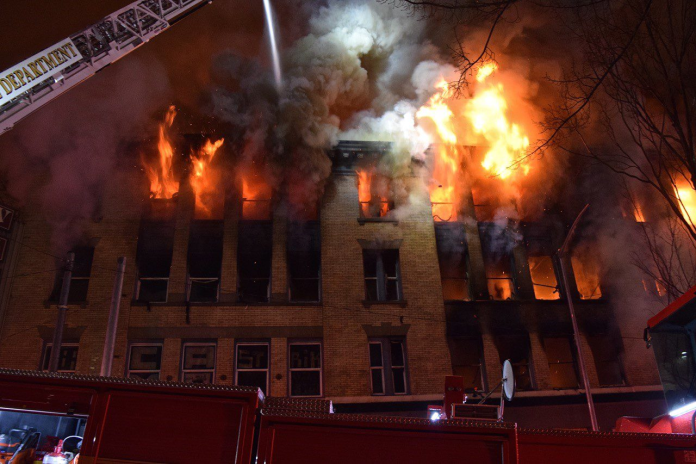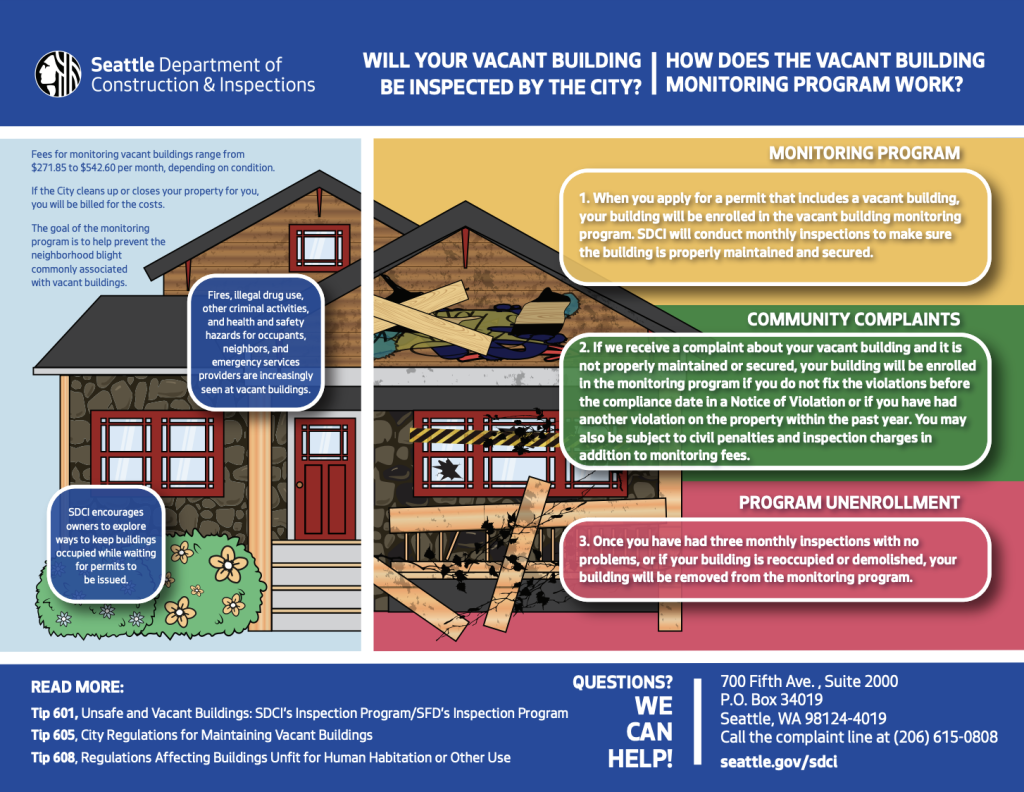
Vacant building fires have become increasingly common in Seattle in recent years. In response to the threat that these fires can pose, Mayor Bruce Harrell proposed emergency legislation on Thursday to enact additional authority to more speedily order and carry out demolition or mitigation of vacant buildings deemed an “unsafe condition” under the Seattle Fire Code.
The emergency legislation would empower the Seattle Fire Department (SFD) to directly remove or abate, in part or in full, an unsafe building and recover any associated costs to accomplish the task from the property owner or person responsible. The City already has similar “chronic public nuisance” laws on the books for properties, but those are delegated to the Seattle Police Department, which rarely enforces them, and is focused on criminal activity beyond unauthorized occupancy.

The City has long grappled with issues associated with vacant buildings and has adopted legislation increasing monitoring of vacant buildings, strengthening requirements on securing them from trespass, and making it easier to remove them, with responsibility for the program in the hands of the Seattle Department of Construction and Inspections (SDCI). Despite these interventions, some issues have persisted.
Just last fall, the city council adopted an ordinance to increase materials required to secure vacant buildings, abate graffiti on vacant buildings, register vacant buildings into the monitoring program earlier, and allow the City to file liens on properties with unpaid vacant building monitoring fees and abatement costs. Monthly costs for inspections range from $271.85 to $542.60, depending upon the condition of buildings, and properties in an ongoing state of violation are subject to daily fines up to $150.
According to City statistics, vacant building fires have rapidly increased in the past few years. In 2021, there were 77 such fires in the city, then 91 vacant building fires in 2022, and then another 130 in 2023. Three people died in vacant building fires last year. Councilmember Tammy Morales noted her Council District 2 has been the epicenter of this crisis, with more than 60 fires in D2 since 2022.
🚨New legislation: ICYMI last week I announced that I will be co-sponsoring a bill with CM Kettle from the Mayor’s Office to address vacant buildings across our city.
— Councilmember Tammy J. Morales (@CMTammyMorales) April 22, 2024
We had over 60 fires in D2 between 2022-23.
I spoke with KING5 at the Jumbo lot. More: https://t.co/yxXTIi8rSr pic.twitter.com/KK3hJpnNAJ
City officials have attributed the uptick in vacant building fires to the homelessness crisis and drug epidemic, suggesting increased activity by squatters or those temporarily turning vacant buildings into drug houses. Without access to safe heating sources, unauthorized occupants have been known to set unsafe fires for warmth inside.
So far this year, there have been 30 vacant building fires in the city. One of those included the three-alarm fire in First Hill that resulted in a total loss of a four-story apartment building on New Year’s Day. It wasn’t the first time for a fire in the building, which last happened in 2022 and led to its vacancy and displacement of tenants from all 63 units. But the January fire was a challenging event requiring more than 100 firefighters to put out the blaze and fighting another fire that had spread to an adjacent apartment building displacing a dozen residents.
Right now, SDCI is monitoring around 300 vacant buildings each month. Of those, about 100 are on the SFD inspection list with 40 of these potentially affected by the proposed emergency legislation. The fire department also estimates that up to 10 properties could be subject to the legislation each year going forward, but that will depend upon the condition of vacant buildings.
The City’s Fire Chief, Harold Scoggins, underscored the importance of the proposed emergency legislation and hailed officials charged with shepherding it.
“Fire responses to vacant buildings have continued to trend upwards. When buildings remain derelict, firefighters often observe holes in the floor, missing stairwells, structural instability, and other hazardous conditions,” Scoggins said in a statement on Thursday. “This presents immense danger to those who may be trespassing, to neighboring dwellings in close proximity to vacant buildings, and to the safety of our fire personnel. I thank Mayor Harrell and Councilmembers Kettle and Morales for prioritizing the safety of our firefighters and the residents of Seattle.”
Approval of the emergency ordinance will require at least seven votes in favor to pass it under supermajority rules. But given the gravity of the challenge and support from the city council’s land use and public safety chairs, the legislation seems poised to pass. Once passed, the ordinance will go into immediate effect.
Doug Trumm is publisher of The Urbanist. An Urbanist writer since 2015, he dreams of pedestrian streets, bus lanes, and a mass-timber building spree to end our housing crisis. He graduated from the Evans School of Public Policy and Governance at the University of Washington in 2019. He lives in Seattle's Fremont neighborhood and loves to explore the city by foot and by bike.

